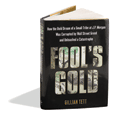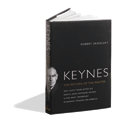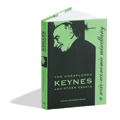Books
Finance & Development, December 2009, Volume 46, Number 4
Failed Discipline
Gillian Tett

Fool’s Gold
Free Press, New York, 2009, 304 pp., $26.00 (cloth).
Every reader of Finance & Development knows by now the broad outlines of the financial crisis that led to the most severe global recession since the Great Depression, from which we are still emerging. And there is certainly no shortage of views, from popular books to academic treatises, on what exactly caused the crisis and what needs to be done to avoid similar crises in the future.
Nevertheless, Gillian Tett’s Fool’s Gold delivers an interesting perspective on the crisis, providing food for thought for anyone interested in the ongoing policy debate, not to mention a lively and entertaining read. Tett heads up financial market coverage at the Financial Times and was named British Business Journalist of the Year in 2008. She is able to describe the roots of the crisis in a way both financial experts and novices can appreciate—indeed, anyone bewildered by the jargon of CDS, CDOs, and ABS will find these instruments demystified, at least to a degree. But her background as a social anthropologist leads her to focus on “how the bold dream of a small tribe at J.P. Morgan was corrupted by Wall Street greed and unleashed a catastrophe.”
While expansionary policies coupled with ineffective regulation and supervision played important roles—as Tett makes clear—the financial crisis overwhelmingly is a story of the failure of market discipline. As the author emphasizes, the instruments developed by JPMorgan and others have the potential either to help control risks or to amplify them, depending on how they are used. Indeed, those at JPMorgan and elsewhere who were instrumental in their development were certain they had unlocked a route to much improved risk management. But, as is now obvious, financial innovation was in many important ways misunderstood and misused.
Low interest rates and declining volatility after 2001 generated accelerated financial innovation, increasing leverage and complexity. As a result, risk multiplied faster than most market participants realized. Securitization that had worked reasonably well for corporate credit default swaps (CDS)—where the basic rule of “know your client” still had meaning—ran into new problems when collateralized debt obligations (CDOs) bundled together dissimilar and increasingly low-quality assets, most notably nonconforming subprime mortgages. Over time, the pricing of mortgage securities increasingly seemed to reflect an assumption that housing prices simply would continue to rise, limiting subprime mortgage risk. In the process, risk models—which, regardless of their complexity, ultimately are based on the notion that the future will resemble the past—were relied on to a degree their creators probably never intended. (The reliance on risk modeling was particularly questionable for new and complex financial instruments for which there was, by definition, little history.) In a similar manner, credit ratings—themselves based in large part on the very models used by financial institutions—took the place of the due diligence investors should have undertaken. And regulations were rendered ineffective in many ways, notably via the rapid growth of the “shadow banking” sector, with complex and often opaque links to the regulated financial system. All these factors left the financial sector vulnerable. Thus, once the crisis struck, it did so with astonishing speed and strength, highlighting relationships between markets and institutions that few understood fully.
Critically—as emphasized in Fool’s Gold—not all financial institutions acted in the same way. Some, such as the book’s protagonists, maintained a solid risk-management approach to financial innovation while participating actively in securitization markets. Others understood the growing risks and took positions that anticipated a weakening housing market.
However, the book makes clear that short-term pressures to show profits in many cases encouraged excessive risk taking. The book discusses how JPMorgan, despite its leading position in the CDS market, was not a major player in the CDO market. Tett describes how some thought the firm was missing opportunities in this market, while competitors built up large and nontransparent risks. She also describes in vivid detail the key players at JPMorgan trying to make the numbers “add up” in an effort to understand how other financial institutions were booking profits on CDOs—only to learn after the bust that their competitors did so only by leveraging themselves to an unprecedented extent by faulty pricing, and in some cases by accumulating huge and hidden risks on their books. But “in the new twenty-first century of finance, very few analysts bothered to pay attention to leverage and risk exposure. They were fixated on data about revenues and reported profits.”
The book’s story is cogent, but the implications for policymakers are far less clear. In fact, the most interesting lessons lie in what is not discussed in depth by the author. In particular, the most striking missing piece in this book—and in ongoing policy discussions—concerns the shareholders and boards of the key financial institutions. What were they doing while their institutions built up large risks, and why was senior management oversight in many—though not all—of these institutions so ineffective? And if this sort of failure of corporate governance was a key cause of the crisis, will a regulatory response by policymakers be sufficient?
As portrayed in the book, moral hazard seems to have played little, if any, role in explaining the shocking lack of proper risk management. As the book makes clear, the major financial players did not take on unsustainable risks because they expected to be bailed out by governments: the developments since September 2008 would have been unthinkable to them a few months, or even weeks, before the crisis struck. In fact, senior managers in affected firms typically suffered large personal losses as the value of their stock holdings declined sharply despite massive public support for their institutions.
And although the potential for individual payoffs was one underlying incentive for the explosion of financial innovation, the potential impact of the compensation reforms under consideration today is far from clear. Many of the major players already had compensation arrangements that broadly conform to current views of best practice. And, more to the point, most of those most deeply involved from the start didn’t see themselves as pumping up short-term profits at the expense of longer-term risks. Many believed they had discovered the tools to manage risk and revolutionize finance for years to come.
Finally, although several postcrisis recommendations blame the “originate to distribute” business model for the securitization boom and bust—see, for instance, calls for underwriters to maintain a minimum level of “skin in the game”—this crisis’ real shocker is the extent to which major financial institutions’ largest losses stemmed from the huge amount of risk they originated and kept on their books.
All this suggests that, while enhancing our systems of regulation and supervision are extremely important, such efforts should not be expected to banish completely the possibility of financial crises. At best, we can hope to make them much less common and less costly. Moreover, while some of the financial innovation that took place was not socially useful, much of it was—or at least could have been if managed properly. Indeed, reviving these markets, subject to enhanced regulation and probably on a reduced scale, will be critical to restoring economic growth.
In the end, Tett endorses some sensible and fairly straightforward policy recommendations—for greater attention to financial matters by central bankers, more capital in the financial system, and simpler and more transparent financial products. But she also emphasizes the need to rethink the “culture of finance,” with a “return to the dull virtues of prudence, moderation, balance, and common sense.” She argues that ideology, broadly understood, played a key role in forming the financial crisis—in large part through “social silences,” or the failure to raise uncomfortable truths.
At the same time, the crisis has inspired broad-based and innovative approaches to reform that promise to help supplement the hard lessons absorbed by market participants over the past two years. The principal goal is that the financial system, specific institutions, and the individuals who compose them will better understand, measure, and manage the risks that are an integral aspect of markets.
John Lipsky
First Deputy Managing Director, IMF
(Lipsky was Vice Chairman and, before
that, Chief Economist of JPMorgan Investment Bank during 1997–2006)
Keynes Is Alive in the Long Run

Robert Skidelsky
Keynes: The Return of the Master
Public Affairs, New York, 2009, 250 pp., $25.95 (cloth).
Anand Chandavarkar

The Unexplored Keynes and Other Essays:
A Socio-Economic Miscellany
Academic Foundation, New Delhi, 2009, 346 pp., Rs 995 (cloth).
In 1984, economics Nobel Laureate George Stigler predicted that economics was on its way to becoming the queen of the social sciences. He called economics “an imperial science,” one that was instructing other social disciplines through the work of “economist-missionaries . . . often against apprehensive and hostile natives.” A funny thing happened on the way to the coronation: 25 years after Stigler’s article, the feeling in the air is that economics has as much to learn from other disciplines as it has to teach them. A notable example is the field of behavioral finance, which uses insights from psychology and sociology to understand financial markets. The spate of corporate scandals over the past decade and the recurrence of greed-driven financial crises have led to calls for economics to be more intertwined with ethics. And this year’s Nobel Prize in economics went to a political scientist.
This state of affairs would not have surprised or upset the British economist John Maynard Keynes, the subject of these two books. The roots of economics go back to philosophy; indeed early economists were called “the worldly philosophers.” Skidelsky, a historian, and Chandavarkar, an economist, note that Keynes regarded economics as a moral science, to be used to show people how to lead a “good life”—but to Keynes, says Skidelsky, “a good life was not what made people better off: it was what made them good.” Chandavarkar writes that Keynes searched for policy solutions that combined “economic efficiency, social justice and individual liberty.” This was possible only if economists had a broad understanding of many fields: Keynes wrote that an economist should be “mathematician, historian, statesman and philosopher . . . in some degree.”
Role of confidence
Keynes also assigned great importance to psychology, most notably in his assertion that business investment depended significantly on the state of confidence. He felt, says Skidelsky, that the profit expectations of businessmen were not “solidly anchored in underlying forces of productivity and thrift.” Rather, they were driven by uncertain and fluctuating expectations about the future. Keynes argued that “this feeling of uncertainty waxes and wanes: sometimes people are more confident than at others. When confidence is high, the economy thrives; when it is low, it sickens.”
The collapse of optimistic expectations can thus lead to a collapse of the economy. And when the economy is down, pessimistic expectations, and hence unemployment, can persist. The role of the government is to stabilize the economy by carrying out public investment when private confidence is low. While it is good for the government to spend on something productive, Keynes famously argued, even digging ditches and refilling them was a welcome activity for the government to undertake when the private sector was in the doldrums. “The state of confidence,” Keynes wrote, “is a matter to which practical men always pay the closest attention. But economists have not analyzed it carefully.”
Despite his concerns about its stability, Keynes did not want to bury capitalism. Nor did he want a permanently large role for the state. Chandarvarkar writes that “for the young as for the mature Keynes, the mainspring of economic progress was essentially individual initiative and enterprise in a democratic environment.” The role of the state, Keynes wrote, “is not to do things that individuals are doing already, and to do them a little better or a little worse, but to do those things which at present are not done at all.” He turned his back on communism because it became clear to him that a system that allowed the state to do everything would achieve neither material nor moral goals. Skidelsky writes that trips to the Soviet Union in the 1920s convinced Keynes that “one could not enjoy good states of mind if nothing worked.”
Keynes hoped that people would use the forces of markets and capitalism as a quick way to get rich, but that once they had abundance, they would devote themselves to the good life—appreciation of beauty and the arts and other civilized pursuits. That, after all, was what Keynes did. As Chandarvarkar writes, Keynes “straddled with effortless ease the disparate worlds of ideas and affairs—Cambridge, the City, Whitehall, and Bloomsbury.”
Blind spot
During Keynes’s lifetime the principal economic problem was depression and unemployment in the richer nations, not the economic development of the poorer nations, such as India. Skidelsky says that, despite his emphasis on ethics, Keynes never considered the “human and moral implications of imperial rule or whether the British were exploiting the Indians.” Chandavarkar notes that Keynes’s stance was in “striking contrast” to that of other members of the Bloomsbury Group, such as E.M. Forster and Leonard Woolf.
Ironically, Keynes’s reputation as an economist was first established by his work on developing economies, his 1913 publication Indian Currency and Finance. But Chandavarkar—who retired from the IMF—notes wryly that the book was “written without benefit of a mission to India and discussions with the Ministry of Finance.” (Few things about Keynes’s connection with India escape Chandavarkar’s attention: he mentions a Bollywood film in which the heroine is shown to be absorbed in Keynes’s General Theory.) In fact, Keynes never visited any developing country except for holidays in Morocco and Egypt. Chandavarkar says that one just has to live, in the words of economist Paul Samuelson, with the “paradox that Keynes the cosmopolitan was at the same time the most provincial of British patriots.”
An acolyte of Keynes once said that if a reappraisal of Keynes by later generations does not establish him as “as a truly great man and economist, something will have gone sadly wrong with the definition of greatness.” These two fine books will help ensure that Keynes is always thought of as a great man and a great economist.
Prakash Loungani
Advisor, IMF Research Department
Talk to Me

Jean-Pierre Chauffour
The Power of Freedom: Uniting Development and Human Rights
Cato Institute, Washington, 2009, 212 pp., $22.95 (cloth).
A few years back, when I was leading IMF missions to Africa, I found myself in a discussion with a civil society representative over her country’s budget. She was arguing for more money to fight HIV/AIDS and invoked citizens’ “right” to life-saving treatments as trumping all other spending priorities. It seemed to me there were a raft of such rights, many of which would save lives, and the finance minister still had to make difficult choices in allocating his spending. We weren’t seeing eye to eye. But we got around our differences by agreeing on a palliative measure—more aid—thus postponing the fundamental questions to another day.
When my macroeconomist colleagues and I venture into the field as one among many partners of developing countries, we have similar interdisciplinary discussions that go to the heart of governments’ terribly difficult allocation decisions and the international community’s attempts to help with those decisions. We have neither a common framework nor even a common language. Human rights advocates, economists, donors, field-based development specialists, and government decision makers approach these problems with different paradigms and struggle to communicate. Frustration runs high because the human problem is so acute and so visible. People are dying as we talk.
In his thought-provoking book, The Power of Freedom, Jean-Pierre Chauffour tries to find a common denominator for an interdisciplinary development paradigm. He holds that freedom can bridge the gap between the development and human rights imperatives. Unlike foreign aid, embracing freedom doesn’t paper over or postpone difficult choices. Instead, Chauffour argues, it gives us a framework for communication across disciplines and can spark development that makes people better off and preserves their human rights.
Chauffour takes on both the human rights establishment, born of the 1986 Declaration on the Right to Development, and the development establishment, as perhaps too neatly embodied in the Millennium Development Goals (MDGs). After a fair amount of history and perspective in the first two chapters of Part I, the crux of his argument comes in Chapter 3, on the concepts underlying the human “right” to development, where he argues that too often a moral imperative, “righteousness,” has overtaken any sensible definition of rights. In the next chapter, titled “Practice,” he argues that this has led both the human rights and the development communities into a morass of competing priorities from which there is no visible exit. He makes some thought-provoking forays into just whose rights are being preserved (where his end and hers begin?) and who is meant to preserve them (individuals, states, or the international “superstate”?). Chauffour regards the UN rights processes, the Bretton Woods–inspired Poverty Reduction Strategy Papers, and the MDGs all with skepticism and shines a spotlight on donor aid’s many critics. By the end of Part 1, readers may be ready to give up on coherent development altogether.
But Chauffour goes on to develop the implications of his argument on the power of freedom as a unifying paradigm. Chapter 5’s title (Economic Paradigm) may raise some noneconomists’ hackles, but it lays the groundwork for an interdisciplinary approach, founded on individual freedom. His vision of the state tends toward minimalism—it should stay out of the way of individual development rather than attempt to spur it on. So he touts the building of institutions—reiterating the extensive literature on property rights and adding some interesting observations on the exact meaning of “participation” in development (Chapter 6). The chapter on macroeconomic policy reveals his roots as a macroeconomist. I found it a nice fit into his new paradigm, but I am not sure how well it will convince those from other disciplines of the congruence of macroeconomic prudence and human rights. And economists might balk at the market-solves-all patina, given recent work on information asymmetries and behavioral economics.
But Chauffour admits at the outset that this book is unlikely to fully satisfy every practitioner among the interested disciplines. It is too widely cast to plumb any single discipline’s orthodoxy, but it confronts a lot of that same orthodoxy. It would be easy for us all to retreat into our own disciplines, bring out the volumes of research that give nuance to the principles we espouse, and say Chauffour just doesn’t understand us. This book gives us a glimpse into how others think and the limitations of our own thinking. That’s how we’ll have a real conversation about people’s freedom to develop themselves and their societies as they see fit.
Mark Plant
Deputy Director, IMF African Department


